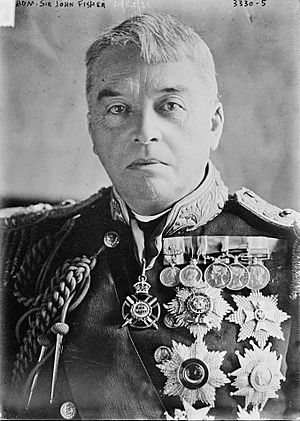Selborne-Fisher scheme facts for kids
The Selborne-Fisher scheme was a big plan for the Royal Navy (the British navy) back in 1903. It was led by John Fisher, 1st Baron Fisher, who was a top navy officer, and approved by William Palmer, 2nd Earl of Selborne, a government leader in charge of the navy. The main idea was to bring together the officers who sailed the ships (called the "military" or "executive" branch) and the officers who ran the ship's engines (the "engineering" branch). The goal was to make sure that the officers in charge of the ship also understood how its powerful engines worked.
Why the Scheme Started
Before this plan, in the early 1900s, ships were becoming much more complex. They relied a lot on machinery and engines. However, the officers who worked with the engines were not always seen as important as the officers who commanded the ships. John Fisher thought this was a problem. He believed the navy would be much better if all officers understood both sailing and engineering.
He wanted everyone joining the navy to have the same basic training. This way, they would learn about both commanding a ship and how its engines worked. Fisher believed that if all new officers learned together, they could later choose to specialize in either sailing or engineering. This idea was new and some people in the navy didn't like it at first, but Fisher managed to convince them it was a good plan.
How the Plan Worked
The Selborne-Fisher scheme officially started in 1903. A few years later, in 1905, even the sailors who worked with the engines (called stokers) became part of the main navy group.
Here's how the training changed:
- Young people joining the navy, usually between 12 and 13 years old, all started their training together.
- They learned the same things until they reached a certain rank, called sub-lieutenant.
- After that, they could choose to become a military officer (who commands the ship) or an engineering officer (who manages the engines).
To help with this new training, a new school was opened in 1903. It was called the Royal Naval College, Osborne, and it was set up in Queen Victoria's old home on the Isle of Wight. Later, a new main college was built in Dartmouth in 1910. Once this new college was ready, the old engineering college was closed because all officers were now trained together.
The Plan Changes Back
After World War I, some people started to think the Selborne-Fisher scheme wasn't working as well as hoped. They felt that officers couldn't be experts in both commanding a ship and engineering at the same time, especially during a war.
Because of this, the navy started to separate the two branches again:
- In 1919, the Royal Naval Engineering College was reopened.
- By 1922, young officers (called midshipmen) started getting special engineering training again, instead of waiting until they were sub-lieutenants.
- The college at Osborne closed in 1921 because it was no longer needed for the combined training.
By 1925, the navy officially ended the Selborne-Fisher scheme. They created many different specialized groups for officers, including Executive (commanding), Engineer, Medical, and others. Even though the scheme ended, one important part stayed: all new officers, whether they wanted to be engineers or commanders, still entered the navy through the same initial training path.
See also


